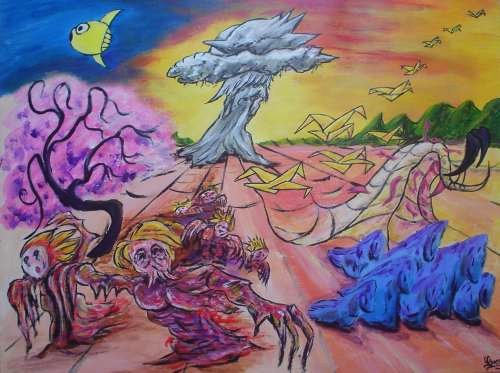After Psalm 137
By the waters of Hiroshima
we wept for the burned children.
We cast chrysanthemums
on the stream and whispered their names
Destroyers required our mirth,
saying “Sing festive songs.”
We hung our guitars on the trees.
We will not sing such songs
to dishonor the ghost children.

Hiroshima Atomic Bomb -- wabyanko
By the waters of Hiroshima
we wept for the burned children.
We cast chrysanthemums
on the stream and whispered their names
Destroyers required our mirth,
saying “Sing festive songs.”
We hung our guitars on the trees.
We will not sing such songs
to dishonor the ghost children.

Hiroshima Atomic Bomb -- wabyanko
By the rivers of Babylon,
ReplyDeleteThere we sat down, yea, we wept
When we remembered Zion.
We hung our harps
Upon the willows in the midst of it.
For there those who carried us away captive asked of us a song,
And those who plundered us requested mirth,
Saying, “Sing us one of the songs of Zion!”
How shall we sing the Lord’s song
In a foreign land?
If I forget you, O Jerusalem,
Let my right hand forget its skill!
If I do not remember you,
Let my tongue cling to the roof of my mouth—
If I do not exalt Jerusalem
Above my chief joy.
Remember, O Lord, against the sons of Edom
The day of Jerusalem,
Who said, “Raze it, raze it,
To its very foundation!”
--Psalm 137
Although one of the "Dead Sea Scrolls" claimed that king David had written 3600 tehilim, plus other conmpositions, and he was explicitly named as the author 73 of the 150 Psalms in the Bible, Psalm 173 was written by the prophet Yirmeyahu (Jeremiah) "For David.... In the Captivity," following the Babylonian conquest of Jerusalem in 607 BCE. It is recited by Jews on Tisha B'Av ("the ninth of Av" in July or August), the saddest day in the Jewish calendar, commemorating the destruction of the First Temple by the Babylonians and the Second Temple by the Romans, as well as other disasters. On 6 August 1945, the United States destroyed nearly 80% of Hiroshima, Japan, in the first-ever use of an atomic bomb, "Little Boy," killing 70,000 people outright, including 20,000 comabtants and 2,000 Korean workers; by the end of the year the death toll rose to 90,000 to 166,000 due to injuries and radiation. The Chrysanthemum Throne (kōi, "Imperial position/rank") is the term used to identify the throne of the Japanese emperor (the takamikura throne in the Shishin-den at the imperial palace in Kyoto),and rhetorically the head of state and the monarchy itself.In 1946 the Ofice of War Information commissioned American anthropologist Ruth Benedict to study postwar Japan in order to understand and predict the culture's behavior during American occupation. Though unable to conduct field research, she relied on newspaper clippings, histories, literature, films, recordings, and interviews of Japanese-Americans to reach her influential conclusions. In particular, "The Chrysanthemum and the Sword: Patterns of Japanese Culture" popularized the notion of the US as a "guilt culture" (a society in which the primary method of social control is the inculcation of feelings of guilt and the expectation of punishment for behaviors that the individual believes to be undesirable) and Japan as a "shame culture" (in which the primary device for maintaining Shame cultures are typically based on the concepts of pride and honour, and appearances are more important than the individual conscience in guilt cultures. As Paul Hiebert clarified the difference in 1985, "Guilt cultures emphasize punishment and forgiveness as ways of restoring the moral order; shame cultures stress self-denial and humility as ways of restoring the social order."